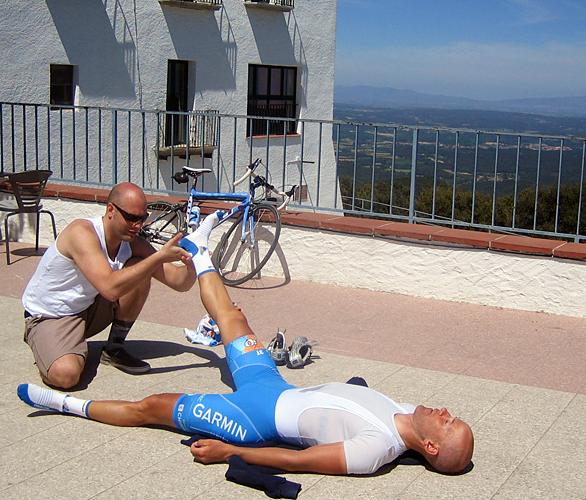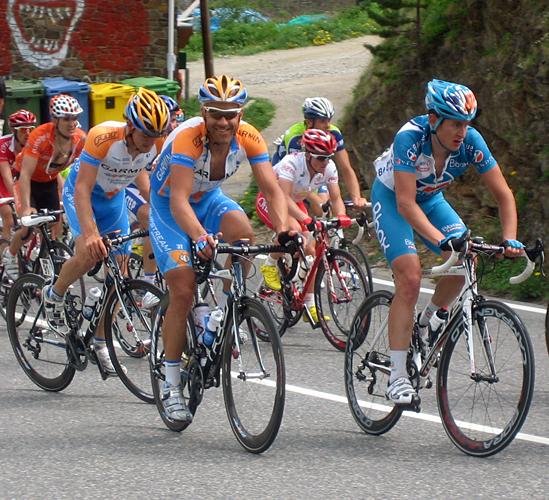

As the Tour de France enjoys a well-earned respite from racing and prepares to enter its third week, the strain on the riders' bodies is obvious. While there are a number of therapies employed to aid in rider recovery and assist in injury management, one that isn't often mentioned is traditional Chinese medicine. Rob Grace explains his experience with using this ancient medical practice in a very modern setting.
At the highest levels of competitive cycling, the margin of difference between riders is slim. Natural talent aside, those who have executed proper training and effective recovery possess the greatest chance of finding the top step of the podium. This article looks at what effective recovery is and how traditional Chinese medicine offers ProTour riders and weekend warriors alike a means of playing the margins and maximising their recuperative potential for greater results on the bike.
Professional cycling is a fantastic testing ground for any health care modality. The pressure is high, the demands on the body are extraordinary, and the environment changes daily. As the margins between winning and not winning are finite, any lingering weakness, illness, or pain can become vastly magnified and hinder performance.
Even the mental awareness of discomfort or of feeling blocked is an inherent limiter on performance and over six hours or one week of racing - let alone three - will inevitably drain the potential energy an athlete has to draw on. I had the opportunity to put acupuncture to the test earlier this season in the lead up to the Tour de France, to see whether rapid and significant change could be made for and felt by the riders of the Garmin-Slipstream team.
Flexible mind, flexible body...
This all began when I heard that Garmin rider, Svein Tuft, was having a tough year following two extremely serious crashes this spring season. One, at the Tour of California, where he sustained a blow to his head, and the second at the Three Days DePanne, where his right knee hit a concrete flower box at 50km/h. He complained of pain with riding, tight and sore hips, and generally a loss of ease and fluidity on the bike. In short, he was suffering and unable to do his job to the fullest.
I caught a plane to Spain and began treatment immediately upon arriving in Girona. We established a regimen of morning and evening treatments, as well as mid-ride fine tunings if it was required. Within four days, the pain was gone and Svein, to his own surprise, reported that he felt straight on the bike and that the power was coming back. His power meter confirmed these sensations. To his credit, Svein is not only an animal on the bike but a thinking man off it. His open mind and willingness to try new things are, to me, the greatest strength he possesses. Flexible mind, flexible body became our operational mantra.
The latest race content, interviews, features, reviews and expert buying guides, direct to your inbox!
The treatment principles
While not disclosing my exact course of treatment with Svein, which would be like trading secrets with the enemy, I will admit that by restoring full perfusion of blood throughout the body and regulating the brain's proprioceptive and sensory centers through a 'hands on' technique I have developed, significant changes were noted.
I based treatment on the following principles:
1. The most critical component of maximising rider recovery is ensuring that at rest, the organism enjoys unimpeded circulation of blood from head to foot.
2. Regulation of the sensory, motor, and vaso-mechanical aspects of the nervous system ensure the athlete spends critical recovery time in a para-sympathetic state.
3. Once these two components have been addressed, more specific pain states, disease states, and injuries can be corrected
In treatment with Svein, who was returning to competitive competition from a six-week layoff due to injury, ensuring these factors were online and keeping him in an empirically demonstrable place where he felt 'good' on the bike, both body and mind occupied a prime position for maximum recovery. He could now focus on doing the work required.
Exploiting the 'window of opportunity'
It was Svein who asked me to extend our stay and work the Tour of Catalonia. With Garmin's permission, I readied for a whole new set of challenges to meet with acupuncture. While I began the tour treating him exclusively, by the fourth day, I was treating most of the guys each evening.
Standard operating procedure for pro riders at the end of any day of a ProTour stage race is to consume a pile of food, have a rub, and relax in the hotel, watch a little TV, fiddle with the Blackberry, eat dinner, and inevitably, bed. This routine is the culture of cycling recovery while on tour, largely unchanged now for many years. I found in my time at the Tour of Catalonia that there exists a wide window of opportunity to exploit in terms of effectively enhancing rider recovery while operating in this traditional routine.
It's difficult to employ a blanket strategy of recovery for a group of individuals, as inevitably each has his own particular needs, his own constitution, and his own set of issues. Such is the strength of acupuncture and Traditional Chinese Medicine in meeting and addressing a mess of different needs in a short period of time.
Acupuncture is generally touted for its ability to reduce inflammation and pain. The reality is acupuncture is employed in all manner of disease treatment from hammer toes to end stage cancer. A typical TCM therapeutics book will cover well over 200 diseases, and this is just the beginning. Acupuncture's application to cyclists is limitless.
During my time at Catalonia, I treated insomnia, fatigue, hot foot, muscular tightness, pain, cough, limited joint mobility, nerve compression, 'dead arm', poor digestion, and one case of 'gan mao' or common cold. Typically, I would have less than three hours to work on roughly four to seven riders, depending on the day and each rider’s specific needs.
I used not only needles but also cupping, patient-specific rubs, moxibustion, and hands on work. In short, acupuncture allows a practitioner to draw on a wide set of tools to meet any health challenge. Each rider continued to receive his daily post-race massage, receiving acupuncture either before or after it.
What did we learn?
In discussion with many of the Garmin riders, a common theme emerged. Many of the guys felt that they had good fitness and could feel the power in their legs but could not access it. I immediately set to work creating protocols of treatment that would enable a rider to have 'good sensations' both on the bike and off.
Chinese Medicine relates our sense of well-being to the qualitative movement and condition of the blood. By perfusing the blood through the body and regulating the vaso-mechanical aspect of the nervous system, bound joints and ropy muscle tissue became loose, enjoyed free movement, and the riders noted a sensation of improved availability of power on the bike. Treatment is painless and demands the patient simply relax and breathe.
It was happy sight to see the guys laid out in bed tacked with needles, snoring away after a long day. This is para-sympathetic money in the bank when it comes to effective recovery.
